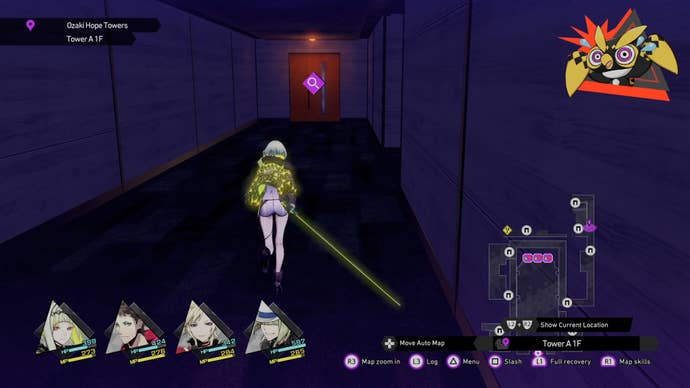An intriguing game marred by primitive visuals and baffling performance.
What’s the longest you’ve ever waited for a video game sequel?
There are some twists, like an overkill-style mechanic that rewards strategic play, and plenty of customization.

But this isn’t especially novel.
Elsewhere, however, this game really shines.
Soul Hackers 2 is a party-oriented title that weaves multiple characters through a winding, serialised story.

That fortunately extends to the rest of the package as well, with a keen sense of visual style.
Let’s start with the good stuff.
On the plus side, the 3D character models are reasonably high in graphical fidelity.

They feature suitably high polygon counts, have good texture work, and are smoothly cel-shaded.
However, the environments really expose the rendering weaknesses.
All of the environmental lighting seems to be baked, and doesn’t affect shadow-casting at all.

The geometry budget is quite limited, which produces chunky-looking curved surfaces.
Texture resolution is questionable, and there’s minimal texture variety.
Cubemaps are remarkably simple and poorly aligned.

Post-processing is limited as well, as the game lacks per-pixel motion blur and bokeh depth of field.
But the results here are very basic and aren’t that far ahead of PS3 and Xbox 360 titles.
Engine differences are certainly part of the picture here, but aren’t the whole story.
It’s safe to say I’m not thrilled with the rendering makeup of Soul Hackers 2.
But there’s an even more conspicuous problem with the visuals in my opinion.
Soul Hackers 2 has very basic environmental artwork for the most part.
Dungeons consist of samey-looking corridors in barren, industrial-style environments, like shipyards and subway terminals.
There’s little to distinguish one room from the next with copy-and-paste corridors and flat lighting.
The game’s city areas do look decent however.
These zones are admittedly pretty small, and the rendering foibles still annoy.
Image quality is, perhaps not surprisingly, behind the curve as well.
There’s no anti-aliasing whatsoever.
The relative lack of geometry ironically helps a bit here, minimising visible aliasing in some scenes.
Still, expect a shimmery presentation.
Even high resolutions don’t fix the problem.
There’s just the one option there, delivering a bizarre 2048x1152 resolution, with an unlocked frame-rate.
On PS5, the performance mode hits 60fps almost all of the time.
You’ll often notice a brief clutch of dropped frames while these attacks are onscreen.
Series X doesn’t fare nearly as well with this option.
Certain cutscenes see prolonged performance dips as well.
The combat issues are understandable, but the other problems don’t make as much sense.
Series S plays out much the same, even with its drastically reduced pixel count.
Starting on Xbox One S, the performance is miserable.
Soul Hackers 2 tends to run between 15-35fps here, with city environments proving extremely taxing.
Most cutscenes hang in the 20s, while combat fluctuates wildly.
For some reason, Atlus has elected for an uncapped frame-rate which feels totally unsuitable for these frame-rates.
Performance tanks further when fast-forwarding through cutscene sequences, though all the last-gen machines have issues in these segments.
One X fares somewhat better.
PS4 is the first last-gen machine that actually manages to turn out sort of consistent performance.
Of all the last-gen machines, this is definitely the one to go for.
Atlus’s decisions with Soul Hackers 2 seem very odd though.
Why leave the Xbox One versions uncapped?
Why run One X at 4K, and PS4 Pro at 1080p?
I’m genuinely befuddled.
I love the Atlus games generally but I’m of two minds about Soul Hackers 2.
The game itself is very good, combining strong characters, a satisfying combat system and excellent music.
The graphics, however, are simply well below par.
As a contemporary full-price release Soul Hackers 2 falls below just about every technical standard.